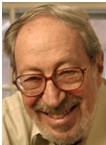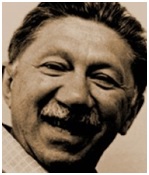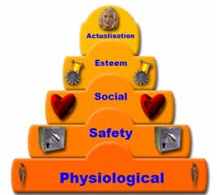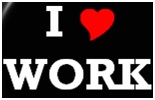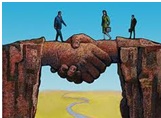|
 |
|
 |
|
|
||
Motivation
Motivation is... Working harder (or effort) on the right things like customer satisfaction.
What affects people's performance? 1. Effort (motivation)
2. Ability
3. External factors (e.g. luck and the people you know).
So motivation isn’t enough on its own – it’s useless without ability. Highly paid people may not work hard because they hate their jobs. People must be encouraged to do the best they can and get out of the comfort zone, where people are content to jog along and not push themselves.
Why is the psychological contract important? This is the unwritten agreement between the employer and employee about the rewards you receive in exchange for the effort you put into a job (sometimes called the work-effort bargain). If people don't receive the rewards they expect (like job security), they won't work as hard. The term comes from Professor Edgar Schein’s (pictured right) book, Organizational Psychology.
What's the difference between motivation and empowerment? Methods of motivation (motivators) are externally applied (e.g. pay). Self-motivation (closely associated with empowerment, or taking responsibility for results) comes from within each person.
Does motivation increase profit? Yes! Research by the American Department of Labour shows that motivation and empowerment lead to higher profits and productivity (output per person).
How to motivate people 1. Pride, principles and leadership People will work harder, if they believe in what the organization is doing (called identification) e.g. charities. So an organization must be ethical and socially responsible and have leaders and managers who inspire people.
2. Satisfy their needs This will reduce absenteeism and stop people leaving and is likely to increase effort (but not always – need satisfiers like longer breaks can be unproductive!). Abraham Maslow (pictured right) in his book Motivation and Personality (1954) said that people satisfy their needs in a particular order (what he called the “hierarchy of needs”): First - physiological needs (food, water, warmth and sex).
Second – safety (or security) needs (physical and psychological security).
Third – love (or social) needs (affection, friendship and a sense of belonging e.g. in groups).
Fourth – esteem (or ego) needs (self-esteem, image, respect from others).
Fifth and last – self-actualization needs (creative fulfilment, learning and self-improvement).
Maslow said people only word harder to satisfy the needs they haven’t satisfied – once one level of needs is satisfied, they work harder to satisfy the next level and so on. But love, esteem and self-actualization needs (called higher order needs) are difficult to satisfy fully. The other lower order needs (physiological and safety) are largely satisfied by money.
3. Empowerment (taking responsibility for results) People work harder when they are self-motivated to take responsibility for their work.
4. Involvement and communication Involve people in the decisions affecting their jobs. Two-way communication is vital – sharing information, listening to people’s views and receiving feedback on performance. An organization’s structure must be as simple as possible, so that people don’t get bogged down in unnecessary bureaucracy and paperwork.
5. Reward people for extra effort People will work harder, if they are given extrinsic and intrinsic rewards:
a) extrinsic rewards Given to people like pay and other financial benefits - for example:
Pay should be:
Giving people a generous share of the profits (profit sharing) also motivates people. b) intrinsic rewards Interesting, varied and worthwhile work with the right balance between work and leisure (work-life balance). People are unique, so rewards should adapt to their different requirements. Therefore, flexible benefits are effective, where employees choose from a menu of alternative financial benefits.
6. Recruit quality people People must be chosen with the right attitudes and abilities for empowerment, lifelong learning and excellence at work. In return the organization must invest in its people through continual education and training.
7. Trust people Management and employees must trust and respect one another – how?
a) quality of treatment
b) respected managers To win respect managers must
c) perfect procedures Procedures concerning things like discipline and pay should be:
d) fair employee appraisal/evaluation (or performance review) – including:
8. Remember the 5 I’s of motivation The 5 I’s summarize the ways to motivate people:
Key quotes explained
“Pleasure in the job puts perfection in the work” - Aristotle (Greek philosopher, pictured right) Dale Carnegie, the American self-improvement expert, said the only way to motivate people is making them “want to do it”. Pleasurable work is vital to not only this self-motivation but also the quality of your performance. “The only way to do great work is to love what you do”, the co-founder of Apple, Steve Jobs, said. Motivation also comes from a loving sensitivity to people’s needs. “We put our love where we have put our labour”, said the American philosopher, Ralph Waldo Emerson.
“Small is beautiful” - Fritz Schumacher (English economist, pictured right) People are better motivated in small units (e.g. teams and small companies) where they feel more in touch with their bosses and fellow employees.
“You can’t put in what God left out” - Sam Mussabini (coach to Harold Abrahams, 1924 Olympic sprint gold medallist and star of the film, Chariots of Fire, pictured right) To perform well someone must have ability as well as effort.
“He is well paid that is well satisfied” - Portia (in Shakespeare’s, pictured right, The Merchant of Venice) Job satisfaction is a powerful motivator.
Best books
Douglas McGregor (pictured right) , The Human Side of Enterprise (1960) There are two approaches to motivation:
(For more detail see The Human Side of Enterprise in the Business Books section).
Peter Martin and John Nicholls , Creating a Committed Workforce (1987) There are three ways to motivate people:
Eric Trist (pictured right) , Organizational Choice (1963) An organization is a “socio-technical system”, made up of people and machines, and so you must satisfy the requirements of both. In 1950’s Britain, new coal cutting equipment didn’t improve the performance of miners, because their work groups were broken up, and they weren’t happy. The groups were re-formed and performance rose sharply.
Frederick Herzberg (pictured right) , Bernard Mausner and Barbara Snyderman, The Motivation To Work (1959) Four main things motivate people (“motivator factors”) that relate to the job itself:
Everything else about a job Herzberg and his colleagues called hygiene factors:
If hygiene factors are bad, people are unhappy with their work and are more likely to leave or be absent. But, if they’re good, they don’t motivate people. So money (or pay, a hygiene factor) doesn’t motivate!
Victor Vroom (pictured right) , Work and Motivation (1964) Vroom’s expectancy theory of motivation says that people will only be motivated, if they expect to be rewarded for harder work.
J.K. Galbraith (pictured right) , The New Industrial State (1967) People work hardest when their objectives are the same as the organization’s, because work is considered worthwhile e.g. charity work (called identification). There are three other ways of motivating people:
Richard Hackman (pictured right) and Greg Oldham (pictured right below), Work Redesign (1980) There are five things in jobs that motivate people:
David McClelland (pictured right) , The Achieving Society (1961) The need to achieve (“n ach”) is the most important motivator.
Amitai Etzioni (pictured right) , Modern Organizations (1964) An organization’s success depends on three sources of power over its employees:
|
|
|
||
|
|
||
| Copyright © wisdomtowin.com 2025 All Rights Reserved | ||
|




